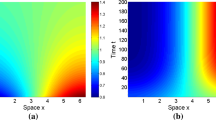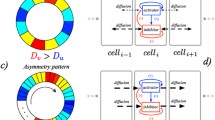Abstract
The problem of pattern formation in a generic two species reaction–diffusion model is studied, under the hypothesis that only one species can diffuse. For such a system, the classical Turing instability cannot take place. At variance, by working in the generalized setting of a stochastic formulation to the inspected problem, spatially organized patterns can develop, seeded by finite size corrections. General conditions are given for the stochastic patterns to occur. The predictions of the theory are tested for a specific case study.




Similar content being viewed by others
Notes
The fact a discretised domain can produce wave modes that do not exist in the continuum case was also noticed in Woolley et al. (2011).
For the sake of simplicity, and without loosing generality we will set \(a=1\) in the following.
References
Asslani M, Di Patti F, Fanelli D (2012) Stochastic Turing patterns on a network. Phys Rev E 86:046105
Belousov BP (1959) A periodic reaction and its mechanism in collection of short papers on radiation medicine for 1985. Med Publ Moschow (A. M. Zhabotinsky, Biofizka) 9:306–311
Biancalani T, Fanelli D, Di Patti F (2010) Stochastic waves in a Brusselator model with nonlocal interaction. Phys Rev E 81:046215
Biancalani T, McKane AJ, Galla T (2010) The linear noise approximation for reaction–diffusion systems on networks. Phys Rev E 81:046215
Black AJ, McKane AJ (2012) Stochastic formulation of ecological models and their applications. Trends Ecol Evol 27(6):337–345
Butler T, Goldenfeld N (2011) Fluctuation-driven Turing patterns. Phys Rev E 84:011112
de Anna P, Di Patti F, Fanelli D, McKane A, Dauxois T (2010) A spatial model of autocatalytic reactions. Phys Rev E 81:056110
Ermentrout B, Lewis M (1997) Pattern formation in systems with one spatially distributed species. Bull Math Biol 59(3):533–549
Fanelli D, Cianci C, Di Patti F (2013) Turing instabilities in reaction-diffusion systems with cross diffusion. Eur Phys J B 86:142
Gillespie DT (1976) General method for numerically simulating the stochastic time evolution of coupled chemical reactions. J Comput Phys 22:403
Gillespie DT (1977) Exact stochastic simulation of coupled chemical reactions. J Phys Chem 81:2340
Goldbeter A (1996) Biochemical oscillations and cellular rhythms. Cambridge University Press, Cambridge
Levin S (1992) The problem of pattern and scale in ecology. Ecology 73:1943
Lodish H (2002) Molecular cell biology. W. H. Freeman and Company, New York
Lugo C, McKane A (2008) Quasicycles in a spatial predator–prey model. Phys Rev E 78:051911
McKane AJ, Biancalani T, Rogers T (2013) Stochastic pattern formation and spontaneous polarisation: the linear noise apporximation and beyond. Bull Math Biol. doi:10.1007/s11538-013-9827-4
Murray J (2008) Mathematical biology, 2nd edn. Springer, New York
Paoletti MS, Nugent CR, Solomon TH (2006) Synchronization of oscillating reactions in an extended fluid system. Phys Rev Lett 96:124101
Prigogine I, Lefever R (1968) Symmetry-breaking instabilities in dissipative systems. J Chem Phys 48:1695
Satnoianu RA, Menzinger M, Maini PK (2000) Turing instabilities in general systems. J Math Biol 41:493–512
Schnakenberg J (1979) Simple chemical reaction systems with limit cycle behaviour. J Theor Biol 81(3):389–400
Shumacher LJ, Woolley TE, Baker RE (2013) Noise-induced temporal dynamics in Turing systems. Phys Rev E 87:042719
Strogatz S (2001) Non linear dynamics and chaos: with applications to physics, biology, chemistry and engineering. Perseus Book Group, New York
Turing AM (1952) The chemical basis of morphogenesis. Phils Trans R Soc Lond Ser B 273:37
van Kampen NG (2007) Stochastic processes in physics and chemistry, 3rd edn. Elsevier, Amsterdam
Woolley TE, Baker RE, Gaffney EA, Maini PK (2011) Stochastic reaction and diffusion on growing domains: understanding the breakdown of robust pattern formation Phys Rev E 84:046216
Author information
Authors and Affiliations
Corresponding author
Rights and permissions
About this article
Cite this article
Cantini, L., Cianci, C., Fanelli, D. et al. Stochastic amplification of spatial modes in a system with one diffusing species. J. Math. Biol. 69, 1585–1608 (2014). https://doi.org/10.1007/s00285-013-0743-x
Received:
Revised:
Published:
Issue Date:
DOI: https://doi.org/10.1007/s00285-013-0743-x




